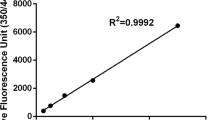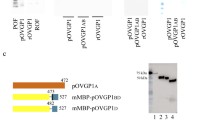Abstract
Plasminogen is present in the oviduct, on the zona pellucida (ZP) and on oolemma, and reduces the number of sperm penetrating the oocyte during in vitro fertilization in pig and cow. It is unknown how this reduction occurs. We tested whether plasminogen (1) changed the ZP resistance to enzymatic digestion thus making the passage of the spermatozoa across it difficult; (2) reduced the sperm functionality, assessed by sperm viability, motility, spontaneous acrosome reaction and membrane lipid disorder; or (3) affected the sperm–ZP binding before or after sperm–ZP interaction. The mechanism by which plasminogen/plasmin system contributes to regulate sperm entry into the oocyte is not inducing a ZP hardening or a decrease in sperm functionality but detaching more than 50% of sperm bound to the ZP. It is suggested that the fertilizing spermatozoon activates plasminogen into plasmin at the oocyte surface and that plasmin removes additional spermatozoa attached to the ZP.
Similar content being viewed by others
References
Castellino FJ, Ploplis VA. Structure and function of the plasminogen/plasmin system. Thromb Haemost. 2005;93(4):647–654.
Zimmerman SW, Manandhar G, Yi YJ, et al Sperm proteasomes degrade sperm receptor on the egg zona pellucida during mammalian fertilization. PLoS One. 2011;6(2):e17256.
Hunter RH, Coy P, Gadea J, Rath D. Considerations of viscosity in the preliminaries to mammalian fertilisation. J Assist Reprod Genet. 2011;28(3):191–197.
Mondéjar I, Grullón LA, García-Vázquez FA, Romar R, Coy P. Fertilization outcome could be regulated by binding of oviductal plasminogen to oocytes and by releasing of plasminogen activators during interplay between gametes. Fertil Steril. 2012;97(2): 453–461.
Coy P, Jiménez-Movilla M, García-Vázquez FA, Mondéjar I, Grullón L, Romar R. Oocytes use the plasminogen-plasmin system to remove supernumerary spermatozoa. Hum Reprod. 2012;27(7):1985–1993.
Liu YX, Ny T, Sarkar D, Loskutoff D, Hsueh AJ. Identification and regulation of tissue plasminogen activator activity in rat cumulus-oocyte complexes. Endocrinology. 1986;119(4): 1578–1587.
Liu YX, Cajander SB, Ny T, Kristensen P, Hsueh AJ. Gonadotropin regulation of tissue-type and urokinase-type plasminogen activators in rat granulosa and theca-interstitial cells during the periovulatory period. Mol Cellular Endocrinol. 1987;54(2–3): 221–229.
Kim NH, Menino AR. Effects of stimulators of protein kinases A and C and modulators of phosphorylation on plasminogen activator activity in porcine oocyte-cumulus cell complexes during in vitro maturation. Mol Reprod Dev. 1995;40(3):364–370.
Park KW, Choi SH, Song XX, Funahashi H, Niwa K. Production of plasminogen activators (PAs) in bovine cumulus-oocyte complexes during maturation in vitro: effects of epidermal growth factor on production of PAs in oocytes and cumulus cells. Biol Reprod. 1999;61(1):298–304.
Liu YX, Liu K, Feng Q, et al Tissue-type plasminogen activator and its inhibitor plasminogen activator inhibitor type 1 are coordinately expressed during ovulation in the rhesus monkey. Endocrinology. 2004;145(4):1767–1775.
D’Alessandris C, Canipari R, Di Giacomo M, et al Control of mouse cumulus cell-oocyte complex integrity before and after ovulation: plasminogen activator synthesis and matrix degradation. Endocrinology. 2001;142(7):3033–3040.
Zhang X, Rutledge J, Khamsi F, Armstrong D. Release of tissue-type plasminogen activator by activated rat eggs and its possible role in the zona reaction. Mol Reprod Dev. 1992;32(1):28–32.
Komar A, Kujawa M. Cortical and zona reactions of heat-activated mouse eggs. J Reprod Fert. 1985;73(2):479–482.
Huarte J, Belin D, Bosco D, Sappino AP, Vassalli JD. Plasminogen activator and mouse spermatozoa: urokinase synthesis in the male genital tract and binding of the enzyme to the sperm cell surface. J Cell Biol. 1987;104(5):1281–1289.
Smokovitis A, Kokolis N, Alexopoulos C, Alexaki E, Eleftheriou E. Plasminogen activator activity, plasminogen activator inhibition and plasmin inhibition in spermatozoa and seminal plasma of man and various animal species. Effect of plasmin on sperm motility. Fibrinolysis. 1987;1(1):253–257.
Liu K, Liu Y, Du Q, et al Preliminary studies on the role of plasminogen activator in seminal plasma of human and rhesus monkey. Mol Hum Reprod. 1996;2(2):99–104.
Kim TS, Sa SJ, Shin MY, et al Stimulation of plasminogen activator activity by free radicals in boar spermatozoa. Anim Reprod Sci. 2009;114(1–3):228–237.
Coy P, Grulló L, Cánovas S, Romar R, Matás C, Avilés M. Hardening of the zona pellucida of unfertilized eggs can reduce polyspermic fertilization in the pig and cow. Reproduction. 2008; 135(1):19–27.
Funahashi H, Cantley TC, Day BN. Synchronization of meiosis in porcine oocytes by exposure to dibutyryl cyclic adenosine monophosphate improves developmental competence following in vitro fertilization. Biol Reprod. 1997;57(1):49–53.
Coy P, Gadea J, Romar R, Matás C, García E. Effect of in vitro fertilization medium on the acrosome reaction, cortical reaction, zona pellucida hardening and in vitro development in pigs. Reproduction. 2002;124(2):279–288.
Parrish JJ, Susko-Parrish JL, Leibfried-Rutledge ML, Critser ES, Eyestone WH, First NL. Bovine in vitro fertilization with frozenthawed semen. Theriogenology. 1986;25(4):591–600.
Rath D, Long CR, Dobrinsky JR, Welch GR, Schreier LL, Johnson LA. In vitro production of sexed embryos for gender preselection: high-speed sorting of X-chromosome-bearing sperm to produce pigs after embryo transfer. J Anim Sci. 1999;77(12): 3346–3352.
Pursel VG, Johnson LA. Freezing of boar spermatozoa: fertilizing capacity with concentrated semen and a new thawing procedure. J Anim Sci. 1975;40(1):99–102.
Gadea J, Gumbao D, Cánovas S, García-Vázquez FA, Grullón LA, Gardón JC. Supplementation of the dilution medium after thawing with reduced glutathione improves function and the in vitro fertilizing ability of frozen-thawed bull spermatozoa. Int J Androl. 2008;31(1):40–49.
Gadea J, García-Vázquez F, Matás C, Gardón JC, Cánovas S, Gumbao D. Cooling and freezing of boar spermatozoa: supplementation of the freezing media with reduced glutathione preserves sperm function. J Androl. 2005;26(3):396–404.
Zhang X, Rutledge J, Khamsi F, Armstrong DT. Release of tissue-type plasminogen activator by activated rat eggs and its possible role in the zona reaction. Mol Reprod Dev. 1992;32(1):28–32.
Rekkas CA, Besenfelder U, Havlicek V, Vainas E, Brem G. Plasminogen activator activity in cortical granules of bovine oocytes during in vitro maturation. Theriogenology. 2002;57(7):1897–1905.
Cherr GN, Drobnis EZ, Katz DF. Localization of cortical granule constituents before and after exocytosis in the hamster egg. J Exp Zool. 1988;246(1):81–93.
Hoodbhoy T, Talbot P. Mammalian cortical granules: contents, fate, and function. Mol Reprod Dev. 1994;39(4):439–448.
Coy P, Cánovas S, Mondéjar I, et al Oviduct-specific glycoprotein and heparin modulate sperm-zona pellucida interaction during fertilization and contribute to the control of polyspermy. PNAS. 2008;105(41):15809–15814.
Van der Ven HH, Al-Hasani S, Diedrich K, Hamerich U, Lehmann F, Krebs D. Polyspermy in in vitro fertilization of human oocytes: frequency and possible causes. Ann N Y Acad Sci. 1985;442(1):88–95.
Author information
Authors and Affiliations
Corresponding author
Rights and permissions
About this article
Cite this article
Grullón, L.A., Gadea, J., Mondéjar, I. et al. How Is Plasminogen/Plasmin System Contributing to Regulate Sperm Entry Into the Oocyte?. Reprod. Sci. 20, 1075–1082 (2013). https://doi.org/10.1177/1933719112473657
Published:
Issue Date:
DOI: https://doi.org/10.1177/1933719112473657




